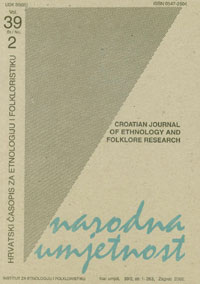Plezsopiszen Maksimilijana Vrhovca ili kako je kolo postalo simbolom zajedništva
Plezsopiszen by Maksimilijan Vrhovec or How the Circle Dance Became the Symbol of Unity
Author(s): Stjepan SremacSubject(s): Cultural Essay, Political Essay, Societal Essay
Published by: Institut za etnologiju i folkloristiku
Keywords: Maksimilijan Vrhovac; circle dance; national renaissance; symbol; Branko Radičević
Summary/Abstract: During his visit to Dalmatia and Croatia in 1818, Emperor Francis II with his wife Caroline on his way back stopped in Zagreb from June 27 till July 1. He was given a grand reception, and among many cultural programmes a dance act Pleszopisen by Bishop Maksimilijan Vrhovec particularly stood out. Vrhovac wrote the lyrics to a folk tune, and noblemen and noblewomen dressed in folk costumes performed (danced and sang) a circle dance. In the lyrics, besides celebrating the imperial couple, Vrhovac made a clear statement of the wish and the political aim that all Croatian countries be unified, as well as the culture and the language. Croatian, Dalmatian and Slavonian women represented the components of the Croatian tripartite state, and the circle dance their unity. The idea to symbolize the unity with a circle dance was soon accepted by main protagonists of the Illyrian movement, but they retained it only in the form of textual, poetic expression. The Illyrians spread Vrhovac's aspiration for unity and togetherness of Croats to the South Slavic nations, including the Bulgarians. The news of the success of Vrhovac's choreography in the same year (1818) reached the Serbs living in Vienna (...) The Serbian poet Branko Radičević was inspired by Vrhovac's Pleszopiszen when writing a circle dance in the poem "Đački rastanak" (A Student's Farewell). It is striking that Radičević does not include Slovenes into his circle dance, and with the existing regional division his further fragmentation goes to people from Dubrovnik, Srijem, Bačva. This is corresponding with the attitudes of Vuk Karadžić, who considers only the people speaking the čakavian dialekt to be Croatians, those speaking the kajkavian dialect are to him close to the Slovenes, and the Croatians speaking the štokavian dialect (and all other people using the štokavian dialect) are actually Serbs (...). After the World War II, "Brankovo kolo" (Branko's circle dance) became obligatory literature in Croatian...
Journal: Narodna umjetnost - Hrvatski časopis za etnologiju i folkloristiku
- Issue Year: 39/2002
- Issue No: 2
- Page Range: 141-158
- Page Count: 17
- Language: Croatian

